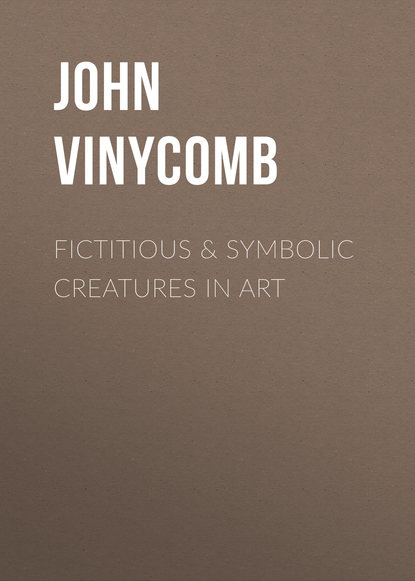 Полная версия
Полная версияFictitious & Symbolic Creatures in Art
The supporters of the Earl of Clanricarde are wild cats, and also those of the Earl of Belmore. It is the crest of De Burgh.
“Æneas.—His mantle was the lion’s,With all its tawny bars,His falchion, like Orion’s,Was gemmed with golden stars.Upon his lofty helmetA brazen terror rode;No sword could overwhelm itWhen in the fight it glowed.For like a wild cat brindled,It spat with eyes on fire,And in the battle kindledImmortal rage and ire,Now in the sunshine sleeping,How gently it reposed;But still in wisdom keepingA single eye unclosed.” Queen Dido, by T. S.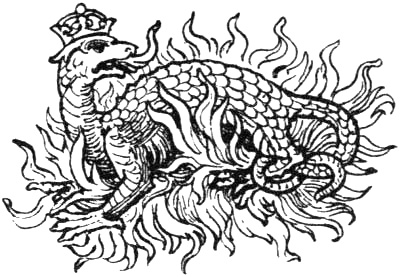
The Crowned Salamander of Francis I.
The Salamander
The salamander has been immemorially credited with certain fabulous powers. Less than a century ago the creature was seriously described as a “spotted lizard, which will endure the flames of fire.” Divested of its supernatural powers it is simply a harmless little amphibian of the “newt” family, from six to eight inches in length, with black skin and yellow spots. The skin was long thought to be poisonous, though it is in reality perfectly harmless; but the moist surface is so extremely cold to the touch that, from this peculiar quality in the creature, the idea must have arisen, not only that it could withstand any heat to which it was exposed, but it would actually subdue and put out fire.
This was a widespread belief long before the time of Pliny, whose account of the creature is thus paraphrased by Swift:
“Further, we are by Pliny toldThis serpent is extremely cold;So cold that, put it in the fire,’Twill make the very flames expire.”Marco Polo, the early Venetian traveller, who tells of many strange and wonderful things seen and heard of in his journeyings, was not a believer in the fabulous stories of the salamander, for he dismisses the subject with the curt remark, “Everybody knows that it could be no animal’s nature to live in fire.” An early heraldic writer of a somewhat later period, with greater credulity, stoutly maintains its reality, and in describing the creature states that he actually possessed some of the hair or down of the salamander. “This,” he goes on to say, “I have several times put in the fire and made it red-hot, and after taken out; which, being cold, yet remaineth perfect wool, or fine downy hair.”
Marco Polo further on assures his readers that the true salamander is nothing but an incombustible substance found in the earth, “all the rest being fabulous nonsense.” He tells of a mountain in Tartary, “there or thereabouts,” in which a “vein” of salamander was found; and so we arrive at the fact that this salamander’s wool was nothing but the “asbestos” of the ancients. It is easy to see why asbestos became known as “salamanders’ wool.” The name resulted from the juxtaposition of ideas, and shows how deeply impressed was the belief in the salamander’s mysterious powers. A late writer tells us that some of the lizard tribe are known to enjoy warmth, and alligators are said to revel in hot water. It needed only that an insignificant member of the genus should have been found among the dead embers of a fire to prove at once the invulnerability of the reptile and its ability to extinguish the flames.
The salamander of mediæval superstition was a creature in the shape of a man, which lived in fire (Greek, salambeander, chimney-man), meaning a man that lives in a chimney. It was described by the ancients as bred by fire and existing in flames, an element which must inevitably prove destructive of life. Pliny describes it as “a sort of lizard which seeks the hottest fire to breed in, but quenches it with the extreme frigidity of its body.” He tells us he tried the experiment once, but the creature was soon reduced to powder.26
Gregory of Nazianzen says that the salamander not only lived in and delighted in flames, but extinguished fire. St. Epiphanius compares the virtues of the hyacinth and the salamander. The hyacinth, he states, is unaffected by fire, and will even extinguish it as the salamander does. “The salamander and the hyacinth were symbols of enduring faith, which triumphs over the ardour of the passions. Submitted to fire the hyacinth is discoloured and becomes white. We may here perceive,” says M. Portal, “a symbol of enduring and triumphant faith.”
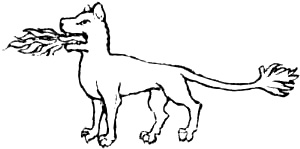
Salamander crest of James, Earl of Douglas. From garter-plate.
This imaginary creature is generally represented as a small wingless dragon or lizard, surrounded by and breathing forth flames. Sometimes it is represented somewhat like a dog breathing flames. A golden salamander is so represented on the garter-plate of James, Earl of Douglas, K.G., the first Scottish noble elected into the Order of the Garter, and who died 1483 a.d. Tinctured vert; and in flames proper it is the crest of Douglas, Earl of Angus.
François I. of France adopted as his badge the salamander in the midst of flames, with the legend, “Nutrisco et extinguo” (“I nourish and extinguish”). The Italian motto from which this legend was borrowed was, “Nudrisco il buono e spengo il reo” (“I nourish the good and extinguish the bad;” “Fire purifies good metal, but consumes rubbish”). In his castle of Chambord, the galleries of the Palace of Fontainebleau, and the Hôtel St. Bourg Thoroulde at Rouen, this favourite device of the crowned salamander, with the motto, may be everywhere seen.
Azure, a salamander or, in flames proper, is the charge on the shield of the Italian family of Cennio.
The “lizards” which form the crest of the Ironmongers’ Company, were probably intended for salamanders on the old seal of the company in 1483, but are now blazoned as lizards.
The heraldic signification of the salamander was that of a brave and generous courage that the fire of affliction cannot destroy or consume.
In the animal symbolism of the ancients the salamander may be said to represent the element of Fire; the eagle, Air; the lion, Earth; the dolphin, Water.
Heraldic Antelope
This fictitious animal, when depicted in heraldry, has a body like that of a stag, the tail of a unicorn, a head like the heraldic tiger, with two serrated horns, and a tusk growing from the tip of his nose, a row of tufts down the back of his neck, and the like on his tail, chest and thighs. Thus represented it is termed an heraldic antelope to distinguish it from the real or natural antelope, which is also borne in modern coats of arms.
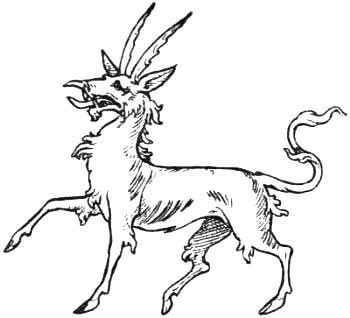
Heraldic Antelope.
The old heralds, with their scant knowledge of the rarer kinds of foreign animals, represented the antelope as a fierce beast of prey, and totally unlike in appearance and in disposition to the beautiful small-limbed gentle creature with which we are acquainted. That such was the prevailing opinion in the time of Spenser is evident. In the “Faerie Queen” he makes the stout Sir Satyrane—
“In life and manners wild,Amongst wild beasts and woods from laws of man exiled.”—more than a match for the most ferocious brutes, all of whom he subdues:
“Wild beasts in iron yokes he would compel;The spotted panther, and the tuskèd boar;The pardale swift, and the tiger cruel,The antelope and wolf, both fierce and fell;And them constrain in equal team to draw.”Some authorities give the heraldic antelope with two straight horns, but as the ancient badge of the House of Lancaster it was represented with two serrated horns curving backward.
In blazon, the term “heraldic antelope” should always be used unless the natural antelope is intended.
The Heraldic Ibex
is an imaginary beast resembling the heraldic antelope in appearance, with the exception of the horns projecting from his forehead, which are serrated like a saw. Perhaps it would not be erroneous to consider it identical with the heraldic antelope.
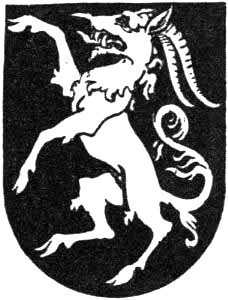
The Heraldic Ibex.
The real or natural ibex is a native of the Alps, the Pyrenees and the Grecian mountains, where they abound in defiance of the hunters. It resembles a goat, but the horns are much larger, bent backwards, and full of knots, one of which is added every year.
Bagwyn
A fabulous beast like the heraldic antelope, but having the tail of a horse, and long horns of a goat curved backwards. The dexter supporter of the arms of Carey, Lord Hundson, in Westminster Abbey, is a Bagwyn.
The Camelopard, Camel-leopard
The Giraffe figures a few times in blazon under these names. It is described by old heralds as half camel and half leopard. A curious word-combination was made by the Romans when wishing to find a name for the giraffe. “It is,” says Archbishop Trench, “a creature combining, though with infinitely more grace, yet some of the height and even the proportions of a camel, with the spotted skin of the pard.” They called it “camelopardus,” the camel-panther.
There are two heraldic creatures based upon the above which are referred to in heraldic works, viz., the Allocamelus or ass-camel, having the body of the camel conjoined to the head of an ass; and the Camelopardel, which is like the camelopard, but with two long horns curved backwards.
Musimon, Tityrus
A fictitious animal mentioned by Guillim and others. It nearly resembles a goat, with the head and horns of a ram, but has besides the horns of that beast, a pair of goat’s horns. It is also mentioned in Guillim’s “Display,” where it is said to be a bigenerous beast, of unkindly procreation, engendered between a goat and a ram, like the Tityrus, the offspring of a sheep and goat, as noted by Upton.
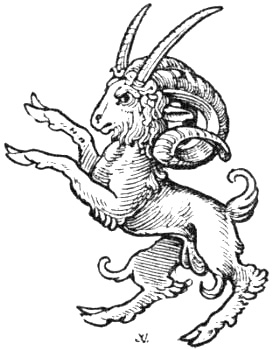
Musimon, Tityrus.
The Enfield
An imaginary hybrid animal with the head of a fox, chest of a greyhound, talons of an eagle, and body of a lion; the hind legs and tail of a wolf. It occurs as the crest of some Irish families of the name of Kelly.
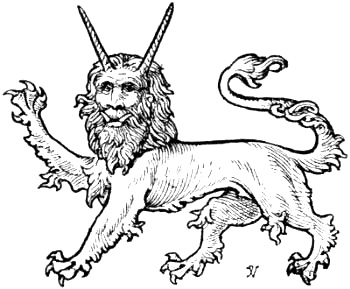
Mantygre—Satyral.
Mantiger, Montegre or Manticora Satyral
A chimerical creature of mediæval invention, having the body of an heraldic tiger with mane, and the head of an old man with long spiral horns. Some heraldic authorities make the horns more like those of an ox, and the feet like a dragon’s.
The Satyral is apparently identical with the man-tiger.
The belief that certain persons have the power of assuming the shape of the tiger is common in India, and the Khonds say that a man-killing tiger is either an incarnation of the Earth’s goddess or a transfigured man. It is thus with the Lavas of Birma, supposed to be the broken-down remains of a cultured race and dreaded as man-tigers.27
Two satyrals supported the arms of the Lords Stawell.
The supporters of the arms of the Earl of Huntingdon are mantigers, but are represented without horns.
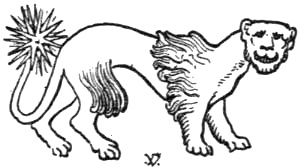
Manticora. From ancient Bestiaria.
From a mediæval “Bestiaria” we have a description and illustration of a gruesome creature of this name (manticora), evolved no doubt from some traveller’s marvellous tale. We are told that it is “bred among the Indians,” has a triple row of teeth, in bigness and roughness like a lion’s, face and ears like a man’s, a tail like a scorpion’s “with a sting and sharp-pointed quills,” and that “his voice is like a small trumpet,” and that he is “very wild,” and that after having his tail bruised, he can be tamed without danger.
There are several other fictitious creatures, which, if we may believe certain old writers, excited the minds of our credulous wonder-loving forefathers. Of these little need be said, as they rarely, if ever, appear in modern works on heraldry, and may therefore be classed as extinct monsters.
Lamia or Emipusa
A curious creature of the imagination is the lamia, of which we are told many fictitious stories. It is said to be “the swiftest of all four-footed creatures, that it is very treacherous and cruel to men. It is stated to be bred in Lybia, and sometimes devours its own young.” It is represented in an ancient “Bestiaria” as having the head and breasts of a woman, and the body of a four-footed animal with flowing tail, the hind feet having divided hoofs. It is “thought to be the creature mentioned in Isaiah xxxiv., called in Hebrew Lilith, as also the same which is mentioned in Lamentations iv.”
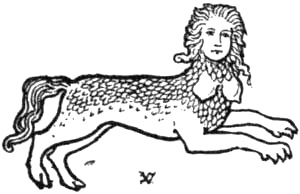
Lamia. From old Bestiary.
In Dr. Brewer’s “Dictionary of Phrase and Fable,” Lamia is “a female phantom whose name was used by the Greeks and Romans as a bugbear to children, from the classic fable of a Lybian Queen beloved by Jupiter, but robbed of her children by Juno; and in consequence she vowed vengeance against all children, whom she delighted to entice and murder.” They are again described as spectres of Africa, who attracted strangers and then devoured them. In the story of “Machatës and Philemon,” a young man is represented as marrying an Empusa, who sucks his blood at night. Goethe borrowed his ballad of the “Bride of Corinth” from this tale.
Beyond casual mention this mythical creature does not appear in heraldry.
Baphomet
A fictitious creature having two heads, male and female, the rest of the body female; said to be used as an idol or symbol by the Templars in their mysterious rites. The word is a corruption of Mahomet. Though mentioned in old works it does not now appear in British heraldry.
Apres
A fictitious animal resembling a bull, with a short tail like that of a bear. It is the sinister supporter of the arms of the Company of Muscovy Merchants.
Stelliones
The supporters of the Ironmongers’ Company of London are two lizards. Bossewell describes beasts of similar shape—“Stelliones” as he terms them, evidently in allusion to steel. He says, “Stellio is a beaste like a lysard, having on his back spotts like starres.”28
Stellione-serpent, a serpent with the head of a weasel, borne by the name of Baume.
Fictitious Creatures of the Sea
Mariners in all ages, prone to superstitious fears, have peopled the great deep with beings of the most dreadful kind, all the more wonderful and indescribable because of the mysterious and unknown regions in the sea depths which they were supposed to inhabit. Classic mythology in its wealth of imagery allotted a whole hierarchy of greater and lesser divinities to the government of the watery element, whose capricious ruling of the waves man altogether failed to comprehend. Their fancied terrors, begot in calms and storms, in darkness and in fogs, midst dangers of the most appalling kind, assumed those monstrous and fantastic shapes which their own fears created. The active forces of nature in unusual forms impressed them as the result of supernatural agency, or the “meddling of the gods,” whose favours and protection the mariner, by prayers and supplications, endeavoured to propitiate; and whilst tremblingly he skirts the horizon’s edge in timid ventures, new dangers impel him to promises of greater gifts to assuage the wrathful mood of his angry god or some other equally powerful or more spiteful.
The national god of the Philistines was represented with the face and hands of a man and the tail of a fish. It was but natural that a seafaring people should adopt a god of that form.
“Dagon his name; sea-monster, upward manAnd downward fish: yet had his temple highReared in Azotus, dreaded through the coastOf Palestine, in Gath and Ascalon,And Accaron and Gaza’s frontier bounds.” Paradise Lost, Book i. 462.In the leviathan and behemoth of Scripture are darkly indicated monsters of the great deep. Scandinavian mythology, like that of all bold maritime peoples in old times, is rife with legends of certain great monsters of the sea. The kraken or sea-serpent of popular legend is a myth not yet laid to rest; there is still a lingering belief in the existence of the mermaid.
“With a comb and a glass in her hand, her hand, her hand,With a comb and a glass in her hand.”Popular sea-song.Chief amongst the Grecian sea-divinities stands Poseidon, or Neptune as he was called by the Romans, the potent “ruler of the seas.” He usually dwelt, not in Olympus, but at the bottom of the sea, in a magnificent golden palace in the neighbourhood of Ægæ. He is always represented with a trident, sometimes with a rudder—special symbols of his power over the sea. Accompanied by his wife, fair Amphitrite, he was frequently pictured in royal state in his chariot, drawn through the billows by wild sea-horses, attended by “Triton blowing loud his wreathed horn,” Proteus, “the godlike shepherd of the sea,” and other followers—dolphins leaping the waves and showing their high arched backs in wild gambolings.
Nereus and his fifty daughters, the Nereides, who dwelt in caves and grottos of the ocean—beneficent sea-nymphs,—win the hearts of the sailors, now by their merry sports and dances, now by their timely assistance in the hour of danger. Whilst Nereus and his lovely daughters represent the sea under its calm and pleasant aspect, Thaumas, Phorcys, Ceto present it as the world of wonders, under its more terrible conditions. The storm winds and all the terrors and dangers of the deep were typified under various strange and peculiar forms. Not the least dreaded were the Sirens, fatal sisters, who “spread o’er the silver waves their golden hair,” basked near sunlit rocks, and lured all men to their ruin by their enchanting voices, save only the crafty Ulysses.
These and many others of lesser note, Proteus, Glaucus and the rest, make up the discordant influences that govern the watery element.
Many wonderful stories are told by classic writers concerning these old myths, and innumerable relics of antique art which embody the conceptions of the times are extant in our museums, by which we may judge to what a large extent such ideas influenced the common life and formed the beliefs of ancient peoples.
It is also worthy of observation to note in what manner the ancients sought to identify the various sea-deities and other mythical creatures with the element they lived in. Each was known by his form or the attributes by which he was accompanied. Modern heraldry repeats many of these old-world myths as new-coined fables, so that for their proper understanding and signification it will be necessary briefly to refer to ancient ideas respecting them. Lakes, rivers and fountains had each their impersonation peculiar to them, which will be found referred to in classic story.
Mediæval legend is equally rife with accounts of wonderful creatures of the sea. The change of one form of superstition for another alters but little the constitution of the mind to harbour fears, and the imagination will deceive even the wisest and best so long as Nature’s laws are misunderstood.
Particular whirlpools, rocks and other dangerous places to navigation, are personated under the forms of monsters of various and awful shapes feared by the mariner, who dreads
“The loud yell of watery wolves to hear.”Scylla and Charybdis are two rocks which lie between Italy and Sicily. Ships which tried to avoid one were often wrecked on the other. The ancients feigned an interesting legend to account for their existence. It was Circe who changed Scylla into a frightful sea monster, and Jupiter who changed Charybdis into a whirlpool, the noise of which was likened to the loud barking of dogs; and the monster was therefore represented with savage dogs amidst her scaly folds, and loudly baying.
“Far on the right her dogs foul Scylla hides;Charybdis roaring on the left presides,And in her greedy whirlpool sucks the tides,Then spouts them from below; with fury drivenThe waves mount up, and wash the face of heaven.But Scylla from her den with open jawsThe sinking vessel in her eddy drawsThen dashes on the rocks. A human faceAnd virgin bosom hides her tail’s disgrace;Her parts obscene below the waves descend,With dogs enclosed, and in a dolphin end.” Æneid, Book iii.Homer gives a vivid description of Ulysses passing the rocks and whirlpools:
“Now through the rocks, appall’d with deep dismay,We bend our course, and stem the desperate way;Dire Scylla there a scene of horror forms;And here Charybdis fills the deep with storms.When the tide rushes from her rumbling caves,The rough rock roars, tumultuous boil the waves;They toss, they foam, a wild confusion raise,Like water bubbling o’er the fiery blaze;Eternal mists obscure the aërial plain,And high across the rocks she spouts the main:When in her gulfs the rushing sea subsides,She drains the ocean with the refluent tides:The rock rebellows with a thundering sound;Deep, wondrous deep, below appears the ground.” Odyssey, Book xii.The giants and ogres of romance were never so fearfully armed or clothed by the wildest fiction with so terrible an aspect as the cephalopods, the race to which the cuttlefish or octopus belongs. Eminently carnivorous, voracious and fierce; beneath staring eyes are spread eight strong fleshy arms furnished with tenacious suckers, which adhere with unrelenting pertinacity, and the arms are swiftly twined round the struggling prey, which vainly strives to disengage itself from so fearful and so fatal embrace. Cephalopods of enormous size are sometimes found with arms as thick as a man’s thigh. Homer refers to its tenacity of grip in a simile.
The cuttlefish appears upon ancient Greek coins of Coressus, in allusion to the worship of Neptune, a deity much venerated as the protector of this island.
Amongst the veritable inhabitants of the ocean there are few more extraordinary mammals than the sea-unicorn, Monodon monoceros, the beaked whale of the Arctic seas, twenty to thirty feet from stern to snout. His length is increased about eight feet by his magnificent spirally twisted tusk of the purest ivory, which in reality is simply the canine tooth growing straight out of the upper jaw. One of the royal treasures of Denmark is the narwhal throne of the Castle of Rosenberg. It is the horn of this “strange fish” which has kept up the belief in the existence of the mythical unicorn.
Xiphias gladius, swordfish, is the largest of the thorny fishes, and belongs to the scombers or mackerel group. The sawfish, Pristis antiquorum, ranks by himself between the rays and sharks. He has the long body of a shark and the underside gill openings of a ray. His saw, like the sword of the Xiphias, is a long flattened bony snout, but is double-edged and serrated. It is well known as a weapon among the Polynesian islanders, and, like the sword of the Xiphias, is frequently found buried in the hulls of ocean-going ships.
There are two denizens of the deep which bear the name of sea-horse—one the tiny Hippocampus, the other the mighty walrus. The hippocampus of our public aquariums, a bony pipefish some six or eight inches in length, swimming upright, his favourite position in the water, with the general resemblance of his head to that of a horse, is very striking; anchored to the seaweed stems by their tails they dart on their prey with great quickness.
Hippocampus (ἵππος, hippos, a horse; κάμπη, campe, a bending), the steed of Neptune, had only the two forelegs of a horse, the hinder quarter being that of a dolphin. The word means “coiling horse.”



